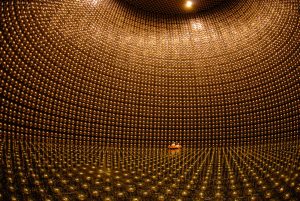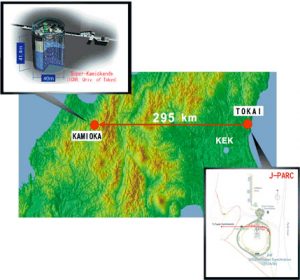
Among the many mysteries surrounding the evolution of our Universe, one of the most fascinating is the complete asymmetry between matter and anti-matter. The current hypothesis is that these two components were created in the same amount during the Big Bang and only later, as the Universe evolved, a process favored matter over anti-matter. This mechanism could depend on an amazing quantum property of neutrinos: the oscillation phenomenon.
Neutrinos are among the fundamental elements of the Standard Model in Particle Physics. Since they do not have electric charge and interact only via the weak force with matter, they are extremely elusive: neutrinos detectors typically weigh from tons to thousands of tons. The Standard Model includes three kinds of neutrinos: electron neutrinos, muon neutrinos or tau neutrinos, and all of them have masses which are yet to be measured, and are supposedly extremely small, less than 1 eV/c2. It is because of these small masses that a neutrino is able to oscillate from one type to another during its motion. Neutrino oscillations have been observed by many experiments, such as Gallex, MACRO, Borexino and OPERA, at the INFN Gran Sasso laboratory.
It is thanks to the observation of the oscillation of the neutrinos coming from the Sun in the SNO experiment, and those produced in our atmosphere in the Super-kamiokande experiment, that Arthur McDonald and Takaaki Kajita were awarded the Nobel Prize in Physics in 2015.
Last August, the T2K (Tokai-to-Kamioka) collaboration presented results showing for the first time that the probability of muon neutrinos turning into electron neutrinos could be considerably higher of their respective anti-particles. In the Standard Model jargon, the difference in the behavior of particles and their anti-particles is called violation of the CP symmetry, that is, the invariance of physical laws under the joined effect of the exchange among particles and anti-particles (conjugation charge, C) and the inversion of spatial coordinates (parity, P). The CP symmetry violation in the Standard Model had so far been observed only in hadronic particles containing s and b quarks.
In the T2K experiment a beam of muon neutrinos (or anti-neutrinos) is produced at the J-PARC (Japan Proton Accelerator Research Complex) in the village of Tokai by the collision of 30 GeV/c protons on a graphite target. Neutrinos are the result of the decay of charged particles called pions, resulting from the interaction of the protons, and focused thanks to special magnetic fields. It is possible to decide whether to produce a neutrino or an anti-neutrino beam simply inverting the magnetic field polarity. Within the J-PARC complex, the INGRID and ND280 detectors measure the energy, flux and probability of interaction of the neutrinos before the oscillations. Finally, the neutrino beam, after passing through 295 km of earth crust, is observed by the Super-Kamiokande detector, located in Kamioka.
The Super-Kamiokande detector contains about 50,000 tons of water; particles produced by the interaction between neutrinos and water emit a small amount of light because of the Cerenkov effect, detected by photomultipliers converting light into electric signals. The different characteristics of the produced light allow to distinguish the interactions of muon neutrinos from those of electron neutrinos, and therefore to measure the probability of muon neutrino disappearance and of electron neutrino appearance.
Statistical evidence is still limited, and a more significant amount of data will be collected in the next few years to verify this first result. The collaboration wishes to keep collecting data with neutrino and anti-neutrino beams until current amount of data will increase tenfold, also thanks to continuous research focused on improving the intensity of neutrino beams. (Alessandro Paoloni)
 INFN-LNF Laboratori Nazionali di Frascati
INFN-LNF Laboratori Nazionali di Frascati
